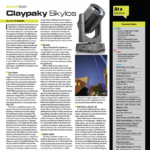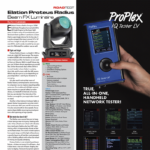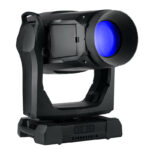I have to start out by saying what a pleasure it is to toy around with a new original light fixture. One that does not copy or emulate any other lighting fixture on the market, but is unique. French lighting manufacturer Ayrton has once again raised the bar with the release of their MagicBlade. I am sitting in the Morpheus Lights showroom in Las Vegas as I run this beauty through its paces. Morpheus Lights distributes Ayrton in America.
A Wide Shaft of Light
 The MagicBlade delivers a wide shaft of light through seven RGBW LEDs. They are lined in a straight array with minimal separation. Each cell has a tight zoom of 4.5°. They resemble PAR 36 bulbs. My favorite spinning gobo in moving lights happens to be the straight line of dots. But for this lighting look to be effective, I had to dim the entire light rig so these beams could be seen. This fixture resembles the same light beam as that gobo would, except it is intensely bright.
The MagicBlade delivers a wide shaft of light through seven RGBW LEDs. They are lined in a straight array with minimal separation. Each cell has a tight zoom of 4.5°. They resemble PAR 36 bulbs. My favorite spinning gobo in moving lights happens to be the straight line of dots. But for this lighting look to be effective, I had to dim the entire light rig so these beams could be seen. This fixture resembles the same light beam as that gobo would, except it is intensely bright.
By using large 15-watt LEDs, Ayrton has ensured that we don’t have to turn off any lights to see these beams. I have individual control of each of the seven cells. These cells appear to be twice the size of the LEDs utilized on the Magic Panel fixture (which Ayrton also manufactures). They feature flicker free illumination, which is necessary when dealing with cameras and televised events.
To get maximum usage out of this fixture, I run it in extended mode, which requires 44 channels of DMX control. I notice this fixture can be run via a multitude of signal streams of connectivity. Besides DMX-RDM, I can run the fixture via Art-Net, Kling-Net or via Ayrton’s partner LumenRadio, which offers a proprietary DMX-RDM wireless connection. If I wanted to, I could also store up to 250 cues to run in stand-alone mode.
Chases, Peel Effects and Strobes
Today, I am running a single 5-pin XLR from the console to the fixture. I decide to write some intensity chases. The lights can work in a peel effect from one end of the light to the other perfectly. I can bounce the effect easily from one side to the other or just keep going in the same direction. By just illuminating the odd cells, then the even ones, I get a cool two-step chase out of the bulbs. By increasing the speed a lot, I can get a cool offset strobe effect.
The fixture strobes well (up to 25 flashes per second), and the MagicBlade comes with a channel of premade effects as well. I can choose any pre-canned intensity effect and adjust the speed easily. The effects remind me of some of the club specialty lights manufactured in the 1990s.
360° Pan and Tilt
The MagicBlade comes complete, of course, with the best pan and tilt movement on the market. Like the MagicPanel, the fixture can continuously pan and tilt 360°, forever. It runs smoothly, with no jerky motions or apparent brakes being applied, as it moves from one pre-focused position to another in 16-bit mode. The fixture is fitted with the latest generation of 3-phase stepper motors.
I am able to run the fixture full speed in a circle effect and have it pause instantly — it can “stop on a dime,” so to speak. This light features a separate movement channel for continuous spinning. If I go between 0 and 50 percent on the consoles’ encoder wheel, the fixture will spin in one direction and vary the speed depending on the DMX value. Once you get past 50 percent, it will reverse and spin the other way. I can grab a fixture and instantly take it from whatever focus it was in and start it moving in continuous rotation mode. Getting out of that mode and back into a standard pan and tilt mode is a little trickier. The light seems to shake around for a second before it gets its bearings and realizes where it is supposed to point.
To try this out, I hang three fixtures vertically on a pipe. I have them all panned at 50 percent, facing me. Then I individually adjust the tilts on the fixtures so one is facing 120° (forward), one is facing 240° (backwards) and the last one is straight down at 360°. I write a cue on the console to lock them in place. Next I write a cue that enables the rotation mode so they all start tilting continuously at the same speed. It gives me the perfect waterfall effect one might use for a rock show, and the fixtures run for several minutes while I note zero change in the tilt processing. I then add another cue that puts them all in a continuous pan mode.
I have achieved full scale Saturday Night Fever. From the front view, the beams appear to widen and steadily shrink as the blade turns. My next cue attempts to park them all with the same pan and tilt values and no rotation. I put zero time on the cue and execute it. It takes almost a second for the light to jerk around and find its home position. But I expect this. It would be simple enough when programming a show to turn these fixtures off for the brief second it takes them to get their bearings straight.
Color Mixing and Output
Color-wise, I am impressed. I notice rich reds and magentas though the MagicBlade’s RGBW internal color mixing. Like typical LEDs, it can manufacture any color except good lavender. The dark blue hue is sexy and still fairly bright. I roll all four colors at full and get an off-white hue to the fixture output. It reaches 2500 lumens in intensity, which is good for this type of eye candy.
There is a selection of white color correction presets one can add into the color mixing. There is also a separate channel for a color wheel. This is simply Ayrton’s way of assigning a different color for every increment of DMX on a designated channel. So when this channel changes in value, the color changes drastically and randomly to the next one, mimicking the color wheel on a standard moving light.
The fixture itself has a sleek black casing and stealth design, molded to an aluminum and steel frame. Physically, it is 571mm by 266mm by 184mm (LxHxD) — about 22.5 inches long, 10.5 inches high and only 7.24 inches deep, so it takes up little footprint. These fixtures can be easily tucked under risers. One could line 20 of these along a top rail of a truss and make the ideal “rain curtain” lighting effect.
Each MagicBlade weighs slightly less than 25 lbs. and mounts to any truss with your standard half-coupler clamp. There are heat sinks and variable speed fans inside the fixture to diffuse heat. The operator can set these fans to a level they like for a quieter mode of operation. The fixture also has an automatic overheat shutdown function to protect it should it get too hot.
The fixture has four tiny feet to stand on and two handles to haul it around. The power supply can take anywhere from 100-240 volts AC in through powerCon connectors. EtherCon and 5-pin XLR connectors are panel-mounted by the display for signal.
 At a Glance
At a Glance
Raising the Bar
Ayrton’s compact MagicBlade R offers a straight array of seven RGBW LEDs, each with a tight zoom of 4.5°, in a sleek, stealthy package. Smooth, continuous rotation and impressive color mixing, luminous output and strobe functionality promise to give LDs access to a new variety of innovative effects and looks.
Ayrton MagicBlade R
Pros: Very cool effects, original design, continuous movement, bright.
Cons: No random strobe function built in between the seven LEDS.
How Much: $4,107 (MSRP)
Features & Specs
Optics
- Beam aperture: 4.5°
- Optic Efficiency: 85%
Light Source
- 7 multi-chip 15W LED sources
- Output: Up to 2,500 lumens
- Luminous intensity: 380,000 cd
- Projected Hours of Use: Up to 50,000
Colors
- RGBW LED color mixing
- 4.29 billion colors (8 bit resolution)
Fixture Movement
- Continuous pan and tilt rotation
- Smooth, accurate positioning
- Moving-head operations: 8 or 16 bit resolution
- High-res stepper motors operated via microprocessors
Control
- DMX 512 protocol, through DMX cable or wireless system
- Stand-alone Mode and Master/Slave Modes
- DMX-RDM compatible
- Integrated LumenRadio’s wireless CRMX RDM receiver
- Local control panel, with LCD display and 6 buttons
- DMX 512 Input / Output through XLR5 connectors
- Art-Net and Kling-Net protocol through RJ45 connectors
- Choice of 3 DMX Modes (from 18 to 44 DMX channels)
Power Supply
- 110-240V; 50/60Hz
- 200W max power
- powerCon TRUE1 connectors
Cooling System
- Self-adjusting variable speed fans for quiet operation (Fan Auto Mode)
- Safety protection against temperatures excesses
Size
- 22.5 by 10.5 by 7.24 inches (LxHxD)
Weight
- 11.2kg (24.7 lbs)
For more information, please visit www.morpheuslights.com.



